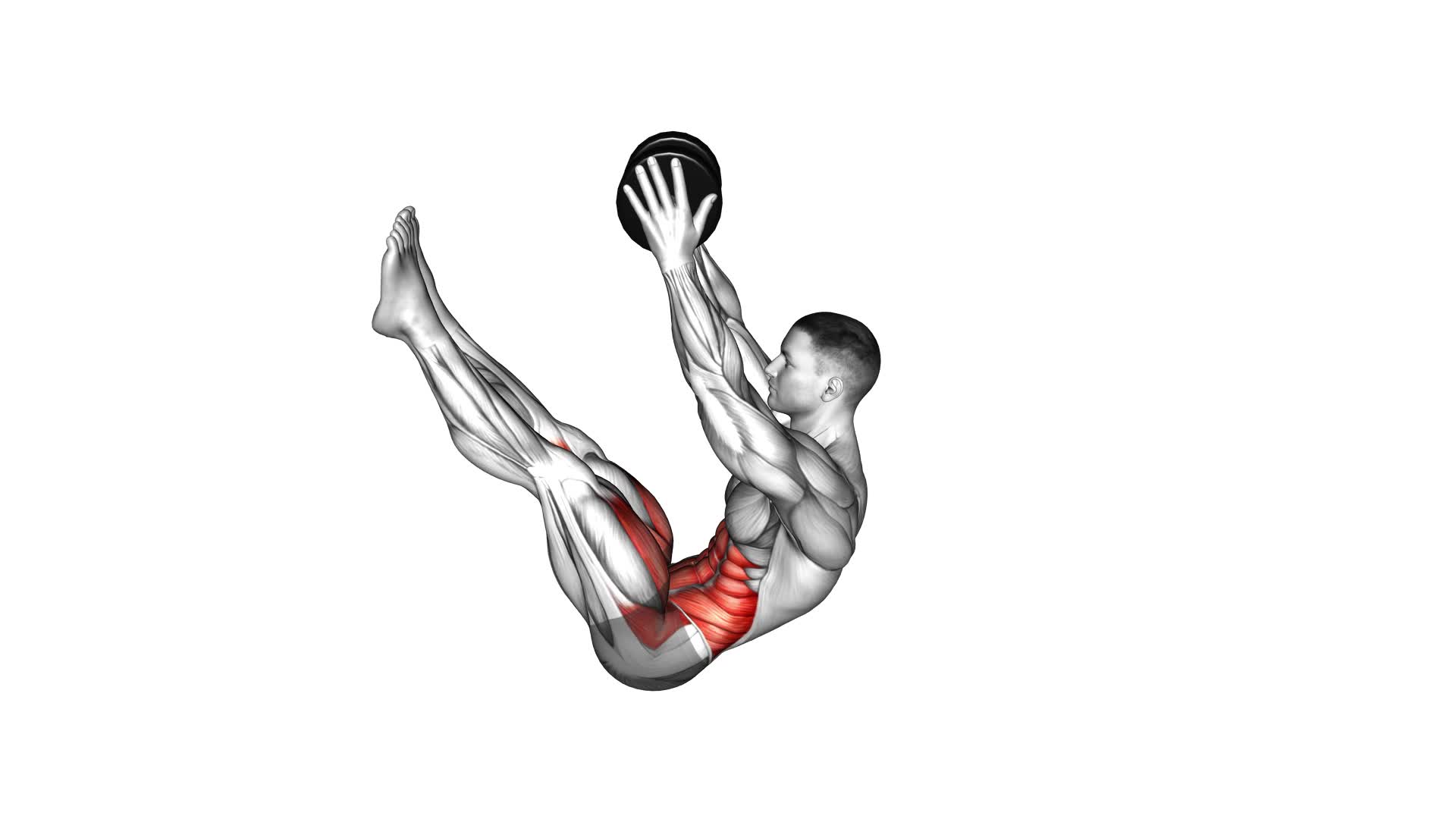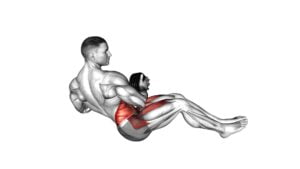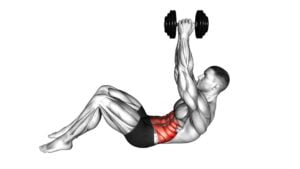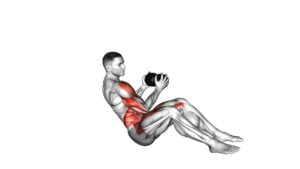Dumbbell V-up (VERSION 2) – Video Exercise Guide & Tips

Are you looking for a challenging ab exercise that targets your core muscles? Look no further than the dumbbell V-up (Version 2).
Watch This Exercise Video
In this video exercise guide, we will show you the proper form and technique to perform this exercise effectively.
You will also find tips to maximize its effectiveness and variations to keep your workouts challenging.
Stay safe and get ready to feel the burn with the dumbbell V-up (Version 2).
Key Takeaways
- The Dumbbell V-Up (Version 2) enhances the intensity and effectiveness of core workouts.
- Engaging additional muscle groups such as shoulders, arms, and upper back.
- Proper form and technique are crucial for maximizing the effectiveness of the exercise.
- There are variations of the Dumbbell V-Up (Version 2) that can be used to keep workouts challenging.
Benefits of the Dumbbell V-up (VERSION 2)
Discover the numerous benefits of incorporating dumbbell v-ups into your workout routine. By adding dumbbells to the traditional v-up exercise, you can enhance the intensity and effectiveness of your core workout. The use of dumbbells engages additional muscle groups, such as the shoulders, arms, and upper back, providing a more comprehensive and challenging workout.
One of the key benefits of incorporating dumbbell v-ups is the ability to modify the exercise to suit your fitness level. By adjusting the weight of the dumbbells, you can increase or decrease the difficulty of the exercise. This versatility allows beginners to gradually build strength and endurance, while more advanced individuals can push themselves to new limits.
Furthermore, incorporating dumbbells into core exercises like the v-up helps to improve overall stability and balance. The added resistance from the dumbbells forces your core muscles to work harder, resulting in increased strength and stability. This can have a positive impact on your performance in other exercises and activities, as well as reducing the risk of injury.
Proper Form and Technique for the Dumbbell V-Up (Version 2)
To properly execute the dumbbell V-up (version 2), continue building on the benefits discussed earlier by incorporating proper form and technique. This exercise can be highly effective for your core muscles if done correctly.
However, there are some common mistakes to watch out for. One mistake is using too heavy of a dumbbell, which can compromise your form and put unnecessary strain on your lower back. It's important to start with a weight that allows you to maintain proper form throughout the exercise.
Another common mistake is using momentum to lift your legs instead of engaging your core muscles. This can reduce the effectiveness of the exercise and increase the risk of injury. To avoid this, focus on using your abdominal muscles to lift your legs and maintain control throughout the movement.
Additionally, if you find the exercise too challenging, there are modifications you can make. You can perform the exercise without a dumbbell or use a lighter weight. You can also bend your knees slightly or perform a modified version of the V-up by lifting one leg at a time.
By paying attention to proper form and making modifications when needed, you can maximize the effectiveness of the dumbbell V-up (version 2).
Now, let's move on to some tips for maximizing its effectiveness.
Tips for Maximizing the Effectiveness of the Dumbbell V-Up (Version 2)
To enhance the effectiveness of the dumbbell V-Up (Version 2), continue to focus on proper form and technique while incorporating the following tips. By following these suggestions, you can maximize your results and avoid common mistakes.
Firstly, ensure that you maintain a strong core throughout the exercise. Engage your abdominal muscles by pulling your belly button towards your spine. This will help you achieve a more controlled movement and target your abs effectively.
Secondly, use a weight that challenges you but still allows for proper form. Start with a lighter dumbbell and gradually increase the weight as you become stronger. This will prevent strain on your lower back and ensure that your abs are doing the majority of the work.
Next, focus on the quality of your repetitions rather than the quantity. Perform each V-Up slowly and with control, feeling the contraction in your abs with each lift. Rushing through the exercise can compromise your form and reduce the effectiveness of the movement.
Lastly, remember to breathe properly throughout the exercise. Exhale as you lift your legs and dumbbell towards each other, and inhale as you lower them back down. Proper breathing not only helps you maintain control but also engages your core muscles more effectively.
Variations to Keep Your Dumbbell V-Up (Version 2) Workouts Challenging
To keep your dumbbell V-Up (Version 2) workouts challenging, try incorporating variations that target different muscle groups. By modifying the exercise, you can continue to challenge your body and prevent plateauing. Here are four advanced dumbbell V-Up variations to add to your routine:
- Single-Leg Dumbbell V-Up:
Start by lying on your back with one leg extended and the other knee bent. Hold a dumbbell with both hands and raise your upper body and extended leg towards each other. This variation engages your core and targets your lower abs and hip flexors.
- Russian Twist Dumbbell V-Up:
Begin in a seated position with your knees bent and feet flat on the floor. Hold a dumbbell with both hands and lean back slightly. Lift your feet off the ground and twist your torso from side to side, touching the dumbbell to the floor on each side. This variation adds an element of rotation, working your obliques and improving core stability.
- Dumbbell V-Up with Leg Raise:
Lie on your back with a dumbbell in both hands, arms extended towards your feet. Simultaneously lift your upper body and legs, reaching the dumbbell towards your toes. As you lower your upper body, raise your legs towards the ceiling, performing a leg raise. This variation targets both your upper and lower abs, as well as your hip flexors.
- Weighted Dumbbell V-Up:
Hold a dumbbell with both hands and perform a standard V-Up, raising your upper body and legs towards each other. The added weight increases the resistance and challenges your core muscles even more.
Incorporating these dumbbell V-Up modifications and advanced variations into your workouts will help you keep your routine challenging and continue making progress towards your fitness goals.
Safety Precautions to Consider When Performing the Dumbbell V-Up (Version 2)
When performing the Dumbbell V-Up (Version 2), it's important to consider safety precautions to ensure proper form and prevent injury. To avoid common mistakes, make sure to start with a weight that you can handle comfortably. Using too heavy of a weight can lead to strain or muscle imbalances. Additionally, keep your core engaged throughout the exercise to protect your lower back. It's crucial to maintain control and avoid swinging the dumbbell, as this can put unnecessary stress on your joints and increase the risk of injury.
Modifications can be made to accommodate different fitness levels or limitations. If you're a beginner or have difficulty with the full movement, you can start by performing the exercise without the dumbbell. This will allow you to focus on mastering the form before adding resistance. Another modification option is to bend your knees slightly instead of keeping your legs straight. This can help reduce strain on your lower back and make the exercise more manageable.
Remember to listen to your body and make any necessary adjustments to ensure a safe and effective workout. By following these safety precautions and modifications, you can minimize the risk of injury and maximize the benefits of the Dumbbell V-Up (Version 2).
Frequently Asked Questions
How Many Sets and Reps Should I Do for the Dumbbell V-Up (Version 2)?
For the dumbbell V-up (version 2), it's important to focus on proper form and technique. Start by lying on your back with a dumbbell in your hands.
Lift your legs and upper body simultaneously, bringing the dumbbell towards your toes. Keep your core engaged and avoid straining your neck.
As for sets and reps, aim for 3-4 sets of 10-12 reps, gradually increasing the weight as you get stronger. Remember to listen to your body and adjust as needed.
Can I Use a Kettlebell Instead of a Dumbbell for This Exercise?
Yes, you can definitely use a kettlebell instead of a dumbbell for the dumbbell v-up exercise. Using kettlebells for core exercises can offer some unique benefits.
Kettlebells provide a different grip and shape, which can challenge your muscles in new ways and improve your grip strength.
Additionally, the off-center weight distribution of a kettlebell can engage your stabilizer muscles even more, enhancing your overall core stability.
Is It Necessary to Have a Spotter While Performing the Dumbbell V-Up (Version 2)?
When performing the dumbbell v-up (version 2), having a spotter isn't necessary. However, having a spotter during weightlifting can provide numerous benefits.
A spotter ensures your safety by assisting you in case you struggle with the weight or lose control. They can also provide motivation and guidance during your workout.
If you don't have a spotter, there are alternatives such as using weightlifting equipment with safety features or modifying the exercise to reduce the risk of injury.
Can I Do the Dumbbell V-Up (Version 2) if I Have Lower Back Pain?
If you have lower back pain, it's important to modify the dumbbell V-up (version 2) exercise to avoid further discomfort or injury. Instead of using dumbbells, try using lighter weights or no weights at all.
Focus on engaging your core muscles and maintaining proper form throughout the exercise.
Alternatively, you can try other exercises that target your abs without putting strain on your lower back, such as planks or seated knee tucks.
What Muscles Does the Dumbbell V-Up (Version 2) Primarily Target?
The dumbbell V-up (version 2) primarily targets your abdominal muscles, specifically your rectus abdominis and obliques. This exercise is great for strengthening your core and improving your overall stability. It also helps to increase your hip flexibility and improve your balance.
There are variations you can try to make it more challenging or to target different areas of your abs. Incorporating dumbbells adds resistance and intensifies the workout, further enhancing the benefits.
Conclusion
In conclusion, the Dumbbell V-Up (Version 2) is a highly effective exercise for targeting the abdominal muscles. By following proper form and technique, individuals can maximize the effectiveness of this exercise.
Additionally, incorporating variations into your workouts can keep them challenging and prevent plateauing. However, it's important to consider safety precautions when performing this exercise to avoid any injuries.
Overall, the Dumbbell V-Up (Version 2) is a valuable addition to any fitness routine.

Author
Years ago, the spark of my life’s passion ignited in my mind the moment I stepped into the local gym for the first time. The inaugural bead of perspiration, the initial endeavor, the very first surge of endorphins, and a sense of pride that washed over me post-workout marked the beginning of my deep-seated interest in strength sports, fitness, and sports nutrition. This very curiosity blossomed rapidly into a profound fascination, propelling me to earn a Master’s degree in Physical Education from the Academy of Physical Education in Krakow, followed by a Sports Manager diploma from the Jagiellonian University. My journey of growth led me to gain more specialized qualifications, such as being a certified personal trainer with a focus on sports dietetics, a lifeguard, and an instructor for wellness and corrective gymnastics. Theoretical knowledge paired seamlessly with practical experience, reinforcing my belief that the transformation of individuals under my guidance was also a reflection of my personal growth. This belief holds true even today. Each day, I strive to push the boundaries and explore new realms. These realms gently elevate me to greater heights. The unique combination of passion for my field and the continuous quest for growth fuels my drive to break new ground.







